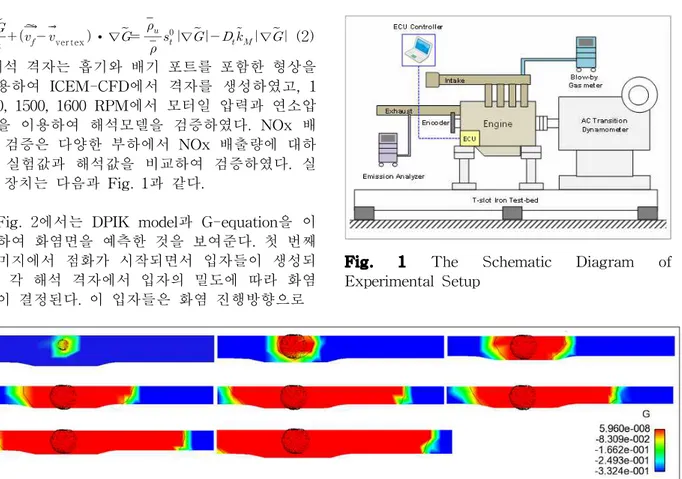제 51회 KOSCO SYMPOSIUM 초록집(2015년도 추계학술대회) 49
LNG 엔진에서 당량비와 점화시기에 따른 엔진의 성능과 배기
특성에 관한 수치 해석적 연구
이지영*․박성욱**†
Numerical Analysis of Performance and Emission Characteristics
according to Equivalence Ratio and Ignition Time of LNG Engine
Ziyoung Lee*, Sungwook Park*†
ABSTRACT
In this research, engine performance and emission variation according to equivalence ratio and ignition time is calculated by validated analysis model. LNG engine ignite by spark plug and spark ignition modeled using DPIK model and G-equation that modeled initial flame surface called kernel and velocity and position of flame front. Engine pressure and emission was validated with experimental data.
Key Words : LNG engine, G-equation, DPIK model, Spark ignition, KIVA
* 한양대학교 융합기계공학과 ** 한양대학교 기계공학부 † 연락저자, parks@hanyang.ac.kr TEL : (02)2220-0430 FAX : (02)2220-4588 환경에 대한 관심이 높아지면서 전 세계적으로 엔진의 배기 규제를 강화하는 추세이다. 강화되 는 배기 규제를 만족하기 위해 후처리 장치를 장 착하거나 연료를 바꾸는 등의 기술들이 개발되고 있는데 그 중 가스 연료를 이용하는 것은 배출물 저감과 함께 석유자원의 의존도를 낮추는 효과도 가진다. 이러한 가스 연료를 이용한 엔진은 차량 에서 뿐만 아니라 열펌프의 동력으로 사용되고 있다. GHP(Gas Heat Pump)에 가스 엔진을 동 력으로 사용함으로써 여름철 전기냉방기 사용량 증가로 인한 전력부족현상을 해소할 수 있고, 전 기를 사용하는 EHP(Electronic Heat Pump)보다 높은 효율을 가진다. 또한 엔진을 구동할 때 발 생하는 배기열을 회수하여 사용할 수 있다는 것 도 에너지 효율을 높이는 요인으로 작용한다. [1 -2] GHP에서 사용하는 가스 엔진은 주 연료가 LNG이며 저속, 부분부하 영역에서 운행되고 부 하와 회전속도의 변동이 크지 않다. 하지만 엔진 이 동력원이기 때문에 엔진에 의한 진동이나 배 기 배출물이 발생하고 열펌프의 성능이 엔진의 효율에 영향을 받기 때문에 LNG 엔진에 대한 연구가 필수적이다. 따라서, 본 연구에서는 LNG 엔진의 최소의 배기 배출물과 최고의 효율을 낼 수 있는 운행조건을 찾기 위해 LNG 엔진 의 해 석 모델을 검증하고 가스 엔진의 성능을 예측하 는 것을 목적으로 한다. 해석과 실험에 사용된 엔진은 GHP에 사용되는 가스 엔진으로 Zero-governor를 통해 흡기포트 에 연료가 공급된다. 흡기포트 전단에서 연료와 공기가 Mixer를 거친 후 실린더 내부로 유입되 기 때문에 균질할 혼합기가 흡기포트에서 실린더 로 유입된다고 가정하였다. 본 연구에서 사용된 해석 프로그램은 KIVA3V -Release 2 이고, LNG는 90%이상이 Methane으 로 이루어져 있기 때문에 해석 연료로 Methane 을 설정하였고 화학반응은 GRI의 A natural gas flame and the ignition mechanism을 이용하였 고, 화학 반응식은 CHEMKIN에서 계산된다. [3-6] 연소모델은 DPIK model과 G-equation model 을 이용하였다. Equation (1) 은 DPIK 모델에서 점화가 시작된 후 생성된 입자들이 화염이 진행 되어 나가는 방향으로 속도를 계산하는 식이고, 초기 화염이 일정 이상 성장하면 연소모델인 G-equation 모델로 전환되며 Equation (2)의 지배 방적식을 풀어 각 노드의 G값을 계산하여 화염 면을 예측한다. (1)
제 51회 KOSCO SYMPOSIUM 초록집(2015년도 추계학술대회) 50 ver tex ∙∇ ∇ ∇ (2) 해석 격자는 흡기와 배기 포트를 포함한 형상을 이용하여 ICEM-CFD에서 격자를 생성하였고, 1 400, 1500, 1600 RPM에서 모터일 압력과 연소압 력을 이용하여 해석모델을 검증하였다. NOx 배 출 검증은 다양한 부하에서 NOx 배출량에 대하 여 실험값과 해석값을 비교하여 검증하였다. 실 험 장치는 다음과 Fig. 1과 같다.
Fig. 2에서는 DPIK model과 G-equation을 이 용하여 화염면을 예측한 것을 보여준다. 첫 번째 이미지에서 점화가 시작되면서 입자들이 생성되 며, 각 해석 격자에서 입자의 밀도에 따라 화염 면이 결정된다. 이 입자들은 화염 진행방향으로
Fig. 1 The Schematic Diagram of Experimental Setup
Fig. 2 Prediction of Flame Front using DPIK model and G-equation 이동하며 두 번째 이미지에서 임계 반지름에 도 달하면 더 이상 이동하지 않고 화염면은 G-equ ation 에 이해 예측된다. 세 번째 이미지에서 G -equation의 지배방정식을 풀어 G(x,t)값이 0인 면을 화염면이라고 가정하여 화염면 외부, 즉 G (x,t)의 값이 0보다 작은 영역을 미연소구간으로 화염면 내부의 G(x,t)의 값이 0보다 큰 영역을 후연소 구간으로 정의한다. 후연소 구간의 화학 종들은 CHEMKIN에서 계산된다.
Fig. 3 Normalized NOx emission of LNG engineaccording to Spark timing and Equivalence Ratio Fig. 3은 다양한 당량비에서 점화시기에 따른 NOx 배출량을 나타낸 그래프이다. NOx 배출량 은 당량비 0.9까지 점차 증가하며 0.9와 1에서 점화시기에 따라 역전되는 구간이 발생한다. 당 량비가 1보다 큰 구간에서는 NOx의 배출량이 점차 감소하며 당량비 0.8부터 1.0까지 구간에서 NOx의 배출량이 점화시기에 영향을 받고 그보 다 작거나 큰 구간에서는 점화시기에 따른 NOx 배출량의 편차가 거의 없다.
Fig. 4 Normalized ISFC of LNG engine according to Spark timing and Equivalence Ratio
제 51회 KOSCO SYMPOSIUM 초록집(2015년도 추계학술대회) 51 Fig. 4는 당량비와 점화시기의 변화에 따른 연 료소비율을 나타내는 그래프이다. 당량비가 0.7 보다 낮은 구간을 제외하고 점화시기가 늦어질 수록 연료소비율은 감소하는 경향을 보인다. LNG의 특성상 연소속도가 느리기 때문에 당량 비가 낮은 구간에서 점화시기를 늦출 경우 연소 기간이 길어지고 점화 플러그와 가장 멀리 떨어 져 있는 연료는 압력과 온도가 낮아진 상황에서 연소하기 때문에 불완전하게 연소되고 연소효율 이 떨어지게 된다. [7] NOx 배출량과 연료소비율을 고려했을 때, 0.8 이상의 당량비에서는 점화시기를 최대한 늦추는 것이 엔진 성능을 향상과 배출물 저감 효과를 기대할 수 있다. 당량비가 0.7이하인 구간에서는 점화시기를 늦추면 불완전 연소가 일어나 엔진 효율을 감소시키므로, 연료소비율이 낮은 영역 에서 연소하는 것이 좋은 것으로 판단된다.
후
기
본 연구는 LG전자의 지원으로 수행되었습니다.참고 문헌
[1] Lazzarin, R. and M. Noro, District heating and gas engine heat pump: Economic analysis based on a case study. Applied Thermal Engineering, 2006. 26(2-3): p. 193-199.
[2] Sanaye, S. and M. Chahartaghi, Thermal modeling and operating tests for the gas engine-driven heat pump systems. Energy, 2010. 35(1): p. 351-363.
[3] Fan, L. and R.D. Reitz, Developmet of an ignition and combustion model for spark-ignition engine. SAE Technical Paper, 2000(No.2000-01-2809).
[4] Tan, Z., S.-C. Kong, and R.D. Reitz, Modeling premixed and direct injection SI engine combustion using the G-equation model. SAE International, 2003(No.2003-01-1843).
[5] Liang, L. and R.D. Reitz, Spark ignition engine combustion modeling using a level set method with detailed chemistry. SAE International, 2006(No.2006-01-0243).
[6] Tan, Z. and R.D. Reitz, An ignition and combustion model based on the level-set method for spark ignition engine multidimensional modeling. Combustion and Flame, 2006. 145(1-2): p. 1-15.
[7] Elia, M., M. Ulinski, and M. Metghalchi, Laminar Burning Velocity of
Methane-Air-Diluent Mixtures. Journal of Engineering for Gas Turbines and Power, 2001. 123(1): p. 190-196.
